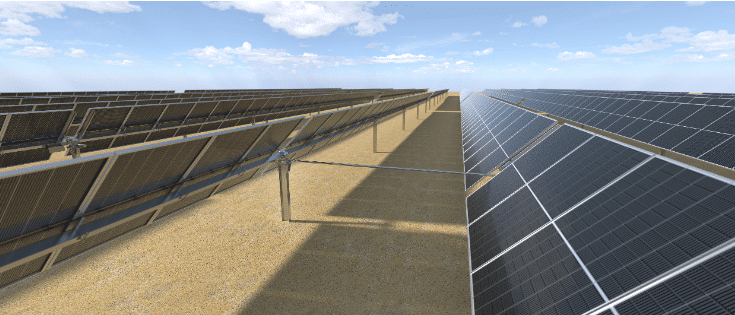Chinese solar manufacturer Trina Solar has unveiled its 670W Vertex solar module and TrinaTracker solutions in India.
The 670W Vertex module is based on 210mm wafers. It inherits the non-destructive cutting, high-density interconnection and other high-precision technologies of earlier Vertex modules. But, Trina Solar India director Gaurav Mathur, said, “The 670W module has even more power and the single string power gets 34% higher than [with] 500W+ modules in the industry.”
“Besides, 670W Vertex modules can be packed vertically – rather than horizontally – which means 12% more modules can be packed in each container, reducing shipping costs by 12% for each module,” Mathur added.
Trina said the multi-busbar technology and high-density interconnection improve the module efficiency to up to 21.6%, while the non-destructive cutting significantly reduces the risks of cell micro-cracking and power loss.
The module, as with other powerful products of the Vertex series, is claimed to reduce, significantly, both the levelized cost of energy (LCOE) and the balance-of-system (BoS) costs of a project, due to the reduced number of arrays that can be achieved with bigger and better-performing panels.
TrinaTracker systems
The launch of the 670W+ Vertex module coincides with the India launch of solutions from the TrinaTracker business. TrinaTracker is a new brand under Trina Solar that focuses on trackers. Its trackers are compatible with Trina Solar modules as well as modules from other manufacturers.
TrinaTracker is available for use with modules from Trina and other manufacturers, for both 166, 182 and 210mm wafer including large-format modules up to 670Wp.
Speaking to pv magazine, Andrew Gilhooly, who heads the TrinaTracker business in Asia Pacific, said, “Trackers are made of different components so currently the tracker components come from various sources. Some components are made by TrinaTracker and some of the components come from various global suppliers. We are currently exploring localized vendor qualification within India to overcome local duties for steelwork not originating in India.”
TrinaTracker sales within India are led by localized Trina module sales people, to ensure clients can benefit from continuity of the support that they already enjoy from the Trina modules business. “Our local India team is capably supported by the APAC region TrinaTracker business for both pre-sales and during project execution and after sales,” said Gilhooly.
Currently, TrinaTracker is launching two types of trackers in India, the Agile tracker and the Vanguard tracker.
The Agile 550-1P dual-row system is designed with one-in-portrait configuration (1P), and can accommodate up to 120 modules per tracker.
The Vanguard 550-2P single-row multi-drive system is designed to support larger modules improving the LCOE without compromising aeroelastic stability. It is compatible with modules based on 158/166/182/210 mm wafer size. It is designed with two-in-portrait configuration (2P), and can accommodate up to 120 modules per tracker.
“We have optimized [these] trackers’ performance in terms of the longer string length possible with [the new, larger] modules. We can fully accommodate these longer strings on longer and wider tracker structures and this means we can have up to 40 modules in a string, unlocking savings not only on the tracker cost on motors and piles but also savings on downstream electrical BOS costs with fewer string cables, combiner boxes, trenches and so on,” said Mathur.
Trina Solar is the only solar module manufacturer that also makes trackers. This combination, the company feels, makes it very helpful for large-scale power plants, especially the low-cost power plants that are very sensitive to investment costs.
“We feel trackers will be coming to India in a big way. Everybody wants to increase the energy output of their projects to achieve a lower LCOE. The combination of trackers and bifacial PV typically deliver a 15-20% boost to yield and accordingly unlock a reduction of 5-8% for LCOE as compared to fixed-tilt,” said Mathur.
“Customers in India have always been very price-conscious. They need to maximize their return on investment. The way to achieve lower LCOE is to use high-power, high-efficiency bifacial modules and smart trackers. Trina Solar makes both, so it is better able to optimize the performance for lower LCOE,” added Mathur.
This content is protected by copyright and may not be reused. If you want to cooperate with us and would like to reuse some of our content, please contact: editors@pv-magazine.com.









1 comment
By submitting this form you agree to pv magazine using your data for the purposes of publishing your comment.
Your personal data will only be disclosed or otherwise transmitted to third parties for the purposes of spam filtering or if this is necessary for technical maintenance of the website. Any other transfer to third parties will not take place unless this is justified on the basis of applicable data protection regulations or if pv magazine is legally obliged to do so.
You may revoke this consent at any time with effect for the future, in which case your personal data will be deleted immediately. Otherwise, your data will be deleted if pv magazine has processed your request or the purpose of data storage is fulfilled.
Further information on data privacy can be found in our Data Protection Policy.